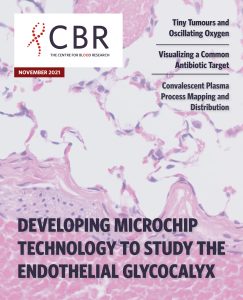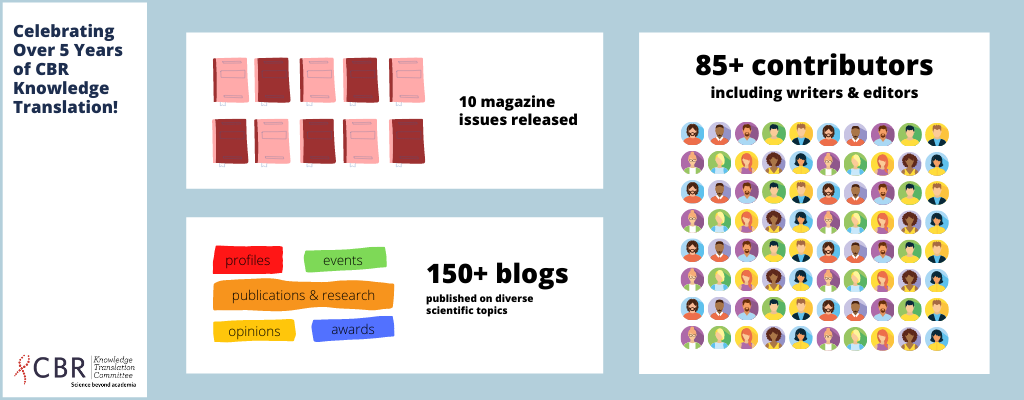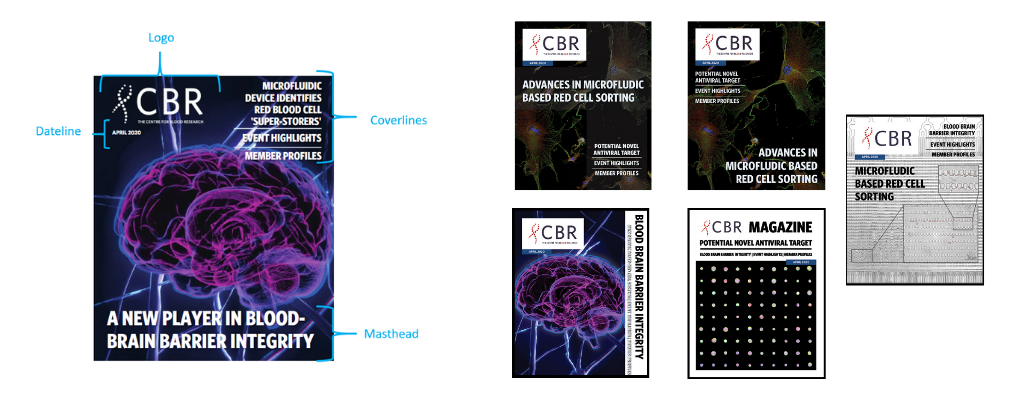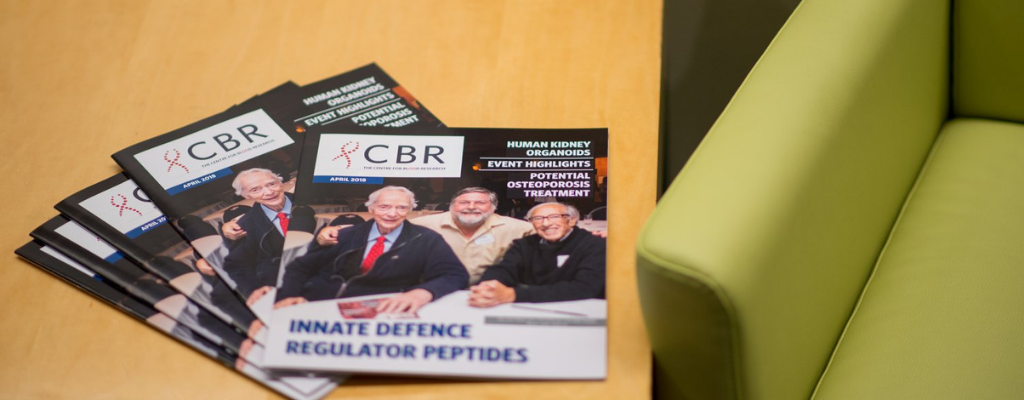 Written by Andy Hsu, former Education Program Assistant (pictured) & Kristine Ho, Communications Coordinator
Written by Andy Hsu, former Education Program Assistant (pictured) & Kristine Ho, Communications Coordinator
Edited by Dr. Stefanie Mak, former Education Program Manager
 Have you ever flipped through an issue of Scientific American or New Scientist and wondered: ‘How are these made? What’s it like to put together a magazine, from start to finish?’
Have you ever flipped through an issue of Scientific American or New Scientist and wondered: ‘How are these made? What’s it like to put together a magazine, from start to finish?’
We used to wonder the same thing. Creating a magazine seemed like a huge undertaking, with lots of deadlines, moving parts, and coordinating with different writers and editors. After working on the CBR Magazine as designers, we can both confirm that this is the case!
Since 2016, the Centre for Blood Research (CBR) has published two magazine issues a year, launching them at major CBR symposia. The magazine showcases original work from the CBR Knowledge Translation Committee, to share their passion for science with the CBR community and beyond.
How does this months-long project come together? Let us walk you through the process, step by step!
There are four key steps to creating the magazine:
- Gathering Content for the Magazine
- Designing the Magazine
- Creating the Magazine Cover
- Proofreading, Final Touches, and Printing
1. Gathering Content for the Magazine
Founded in 2015, the CBR Knowledge Translation Committee is comprised of members who are passionate about science writing, blogging and mixed media communications. Graphic from 2021.
Long before the magazine’s creation, the CBR Knowledge Translation Committee is working diligently behind-the-scenes, writing pieces for the CBR blog. Blogs from the last 6 months form the basis of our magazine content, and our job as designers is to gather them into a single publication.
The Knowledge Translation members sure are an amazing bunch: while juggling research and other commitments, they are actively communicating their passion for science. As you can imagine, without the Committee’s contributions, dedication and enthusiasm, the magazine – and blog – would not exist!
- Learn more about the CBR Knowledge Translation Committee and its legacy in: “Celebrating Over 5 Years of CBR Knowledge Translation!”
2. Designing the Magazine

A behind-the-scenes look at a magazine spread layout, created in Adobe InDesign.
An issue of the CBR Magazine contains 15-20 articles, and we as designers must work with the content to create an engaging, enjoyable reading experience. We decide on visual elements like text size, column width, colours, spacing between words, and more. Above all, we have to put ourselves in the shoes of the reader and ask ourselves questions like:
- Is this font readable? What kind of “personality” does it have?
- Do these colours pair well together?
- If we move this image to the left, will the rest of the page be harder to read?
We each have our own methods for brainstorming ideas and thinking up layouts. For inspiration, Andy browsed Pinterest, an image-sharing site that allowed him to create moodboards and peruse others’ design concepts. Kristine liked to flip through existing magazines like Scientific American. We then brought our ideas to life with Adobe InDesign, a program that can create digital and print publications like magazines, brochures, and flyers.
3. Creating the Magazine Cover

Different cover art design ideas drafted for the CBR Magazine: April 2020 issue, by Andy Hsu and Dr. Stefanie Mak. The leftmost design was selected in the end.
Almost all our magazine covers feature original work by CBR members. These images are submitted to our CBR Magazine Cover Art Contest, which runs concurrently with the magazine design process and offers members a way to communicate science visually. We’ve been fortunate to receive many creative entries over the years, including drawings of arteries, microscopy images, and lab photos.
After the contest ends, we take these images and turn them into covers, adding datelines, a title or “masthead”, and article titles or “coverlines”. We might add also drop shadows to words for increased readability, darken or lighten the cover image, or play with text placement to see what looks best.
- Learn more about our CBR Cover Art Contest and view past submissions in: “From Micrographs to Medical Illustrations: Artwork from our CBR Cover Art Contest”
4. Proofreading, Final Touches and Printing

Finally sharing magazine copies with attendees at the Norman Bethune Symposium!
Now that we’ve covered 3 out of 4 steps, you might think that the magazine is almost complete… but actually, the real challenge has just begun.
Steve Jobs, the late CEO of Apple, once said, “Details matter, it’s worth waiting to get it right.” The same idea applies to magazine creation. Before the magazine is finalized, printed, and released into the world, it goes through a rigorous proofreading process. This often requires 4+ rounds of review from us designers, editors from the Knowledge Translation Committee, and the CBR Director.
We review the magazine multiple times from front cover to back, ensuring that it is stylistically consistent and error-free. This includes correcting typos, removing odd spaces, and ensuring that all elements on a page are present, like the title, byline, body text, images, captions, page number, and magazine section title.
After this, we obtain a print proof of the magazine, which serves as a “test copy” of the final product. The printed copy looks quite different compared to its digital file, so we often make last-minute adjustments to image colours and brightness before printing. Once finalized, our last steps are to publish the digital magazine online and submit an order of 100+ print copies for distribution.
Footnotes and Final Thoughts
Although challenging and time-consuming, magazine creation is a satisfying and great learning experience. There’s nothing more exciting than opening up a box full of magazines that you designed! We highly encourage you to check out the CBR Magazine issues and see the result of everyone’s efforts.
From this experience, Andy said some of his key highlights were gaining technical skills in Adobe InDesign and Photoshop, and exercising his creativity and problem-solving skills whenever he encountered difficulties. He added, “I realized that making a magazine is no easy task, and never would I look at any magazine or printed material in the same way again!”


